1. Introduction
Sony SCD-XA9000ES SACD Player - Page 1
 In
2003, Sony released the SCD-XA9000ES which was Sony's first Super Audio CD
player to provide an
uncompressed digital output for the Super Audio CD's Direct Stream Digital™
signal. This was an i.LINK® digital output, compatible not only with Sony's
own STR-DA9000ES receiver, but also with the latest generation of outboard
D/A converters from other high-end audio companies. This way, the Sony
SCD-XA9000ES helps deliver Super Audio CD sound with effortless clarity,
transparency, impact and presence.
For owners who will connect the player to conventional receivers and
amplifiers, Sony has equipped the SCD-XA9000ES with a Tri Power
Digital-to-Analog Converter using eighteen separate SA DAC chips that deliver
the unprecedented precision of 36 DACs. With either digital or analog outputs,
the SCD-XA9000ES establishes a new and altogether higher standard in music
reproduction.
In
2003, Sony released the SCD-XA9000ES which was Sony's first Super Audio CD
player to provide an
uncompressed digital output for the Super Audio CD's Direct Stream Digital™
signal. This was an i.LINK® digital output, compatible not only with Sony's
own STR-DA9000ES receiver, but also with the latest generation of outboard
D/A converters from other high-end audio companies. This way, the Sony
SCD-XA9000ES helps deliver Super Audio CD sound with effortless clarity,
transparency, impact and presence.
For owners who will connect the player to conventional receivers and
amplifiers, Sony has equipped the SCD-XA9000ES with a Tri Power
Digital-to-Analog Converter using eighteen separate SA DAC chips that deliver
the unprecedented precision of 36 DACs. With either digital or analog outputs,
the SCD-XA9000ES establishes a new and altogether higher standard in music
reproduction.
After our review on the SCD-XB790,
we received from Sony a previous model, the SCD-XA9000ES, which is a hi-end
device,
and has has for a long time been a flagship for Sony.


click to enlarge

- Features and Specifications
- Sony's first Super Audio CD player with i.LINK® (IEEE 1394) interface digital output for the DSD signal
- Super Audio CD multi-channel and two-channel playback
- Compact Disc, CD-R, CD-RW playback
- DSD decoder LSI
- Multi-channel management with bass redirection
- Speaker time alignment
- Tri Power conversion with 36 Super Audio Digital-to-Analog Converters (SA
DACs), six per channel
- Discrete dual laser optical pickup
- Twin R-Core power transformers, one for system and digital the other for
audio
- Frame and Beam (FB) chassis with aluminum front panel
- Off center insulator feet


2. The Super Audio CD Format
Sony SCD-XA9000ES SACD Player
- Page 2
The Super Audio CD Format
Super Audio CD is the most fundamental improvement in digital music
reproduction since the CD itself. No surprise. It comes from the people who
invented the CD: Sony and Philips.
- Hybrid Disc
Furthermore, there is an option to add a separate CD layer to the DVD disc: the so called ‘Hybrid Super Audio CD. Hybrid SA-CD’s can be played back on virtually all CD drives and players as well as all standard DVD-Video systems. This makes Super Audio CD’s compatible with all 11 billion CD and DVD players used around the world.



Every multi-channel Super Audio CD includes a separate 2-channel
stereo mix, done by the hand of the producer—not by a computer.
4 types of Discs
There are four different SA-CD configurations commercially available to record companies:
 The
vast majority of SA-CD’s introduced to the market today are of the hybrid
type, containing the CD layer. This disc plays on a CD and DVD player, at
CD quality.
The
vast majority of SA-CD’s introduced to the market today are of the hybrid
type, containing the CD layer. This disc plays on a CD and DVD player, at
CD quality.
 There
are also SA-CDs without the CD layer, the so-called single layer discs. These
cannot be played on a standard CD player. The advantage is that this is
an entirely secure digital carrier.
There
are also SA-CDs without the CD layer, the so-called single layer discs. These
cannot be played on a standard CD player. The advantage is that this is
an entirely secure digital carrier.
Both the hybrid and single layer SA-CD can be released as a stereo-only album, or as a stereo plus surround album.


Content Protection
Super Audio CD offers the world’s most secure digital carrier, utilizing
a combination of physical and electronic protection barriers. These are layered
around the audio content in five independent layers, including a combination
of mechanical and encryption-based protection systems that cannot be broken
using any current hacking technique.
The end result is that when you buy a Super Audio CD in a music store, you can be confident that it’s the genuine article and not an illegal, inferior quality copy.
The CD layer on the hybrid disc is similar to a conventional CD in that it’s open to copying onto other carriers for home use.
3. i.LINK Digital Output
Sony SCD-XA9000ES SACD Player - Page 3
i.LINK® Digital Output
From the initial launch of the Super Audio Compact Disc, the 1-bit DSD pulse
train was always converted to analog prior to output. While previous Super
Audio CD players did include conventional coaxial and optical digital outputs,
these outputs handled CD signals exclusively. The SCD-XA9000ES is Sony's
first SA-CD player to provide a digital output for the 1-bit DSD signal.

Typical SA-CD reproduction involves numerous D/A and A/D
conversions.
The i.LINK digital connection can simplify the signal path.
This i.LINK digital output is compatible with the i.LINK digital input on
Sony's own STR-DA9000ES as well as a growing number of outboard D/A
converters from other high-end audio companies. The i.LINK interface
maintains the signal in the digital domain and can protect the signal from
repeated D/A and A/D conversions. The i.LINK interface also enables a single
digital cable to take the place of six analog cables.

i.LINK digital output for Super AudioCD
The i.LINK digital audio interface uses Digital Transmission Content
Protection (DTCP), a robust system that protects the music from piracy. The
application of the i.LINK (IEEE 1394) interface for Super Audio Compact Disc
is clearly different from, and not compatible with, previous i.LINK
interface applications for DV camcorders, PC peripherals and professional
digital video
systems. You can only connect the SCD-XA9000ES i.LINK output to a
compatible digital audio input, such as that on the STR-DA9000ES receiver.
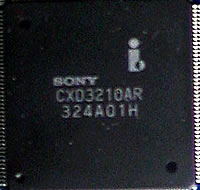
The i.LINK output circuit incorporates a dedicated
Large Scale
Integrated circuit (LSI), Sony's CXD3210.
The design of the interface is exceptional because communicating six
streams of 2.8224 MHz digital samples raises exceptional challenges.
Conveying 1-bit signals at such high data rates and synchronizing the signals
with the other component's master clock would normally expose the signal to the
time-base errors called jitter. These errors translate directly into time-based
distortion of the audio waveform.
The connection from the SCD-XA9000ES to the STR-DA9000ES receiver
overcomes this challenge with the High quality digital Audio Transmission System
(HATS). HATS uses "command-based rate control of isochronous data flow" to
solve the problem. The system incorporates three principal elements.
- Variable-speed transmission from the player
- Buffer memory in the receiver
- Command signals from the receiver to the player, controlling transmission speed
The receiver continually monitors the amount of audio data in its buffer
memory. When the buffer memory reaches its lower limit, the receiver
commands the player to increase data transmission speed. When the buffer
memory reaches its upper limit, the receiver commands the player to decrease
transmission speed. And when the buffer memory is between the upper and
lower limits, the receiver commands the player to transmit at normal speed.

With Sony HATS, audio data flows from the player to the
receiver's buffer memory, according to rate control commands from the receiver.
Reproduction in the receiver
achieves
the full time base accuracy of the receiver's quartz crystal master clock.
In this way, HATS makes it unnecessary to synchronize a jitter-prone
signal with the receiver master clock. Instead, the buffer memory outputs a
jitter-free signal at the full quartz-crystal accuracy of the receiver's master clock.
You get all the benefits of digital transmission, without exposing the signal to the
potential for jitter-induced distortion.
4. DSD Decoder LSI
Sony SCD-XA9000ES SACD Player - Page 4
DSD Decoder LSI
The SCD-XA9000ES processes and decodes the 1-bit signal using Sony's
CXD2752R DSD decoder LSI. This integrated circuit makes intelligent
decisions regarding the incoming data to form the 1-bit audio signal. The
LSI first reads the Watermark, a feature protecting Super Audio Compact Discs
from
piracy, and then decodes the incoming data. The LSI uses a buffer memory
to take data that's output intermittently from the disc and rearrange it
into
continuous 1-bit audio streams. The streams are output according to the master
clock signal from the audio circuit board. The LSI also reads sub code data
such as the Table of Contents, track number, track time, and text.

Multi-channel DSD decoding is handled by a Sony
Large-Scale Integrated circuit (LSI), the CXD2752R.
- Audio Technology for Analog Outputs
While the provision of an i.LINK digital interface for Super Audio CD
signals is a technological tour de force, compatible equipment is just beginning to
become available. Clearly, many owners of the SCD-XA9000ES will be
enjoying Super Audio CD through analog outputs. For this reason, Sony has
developed sophisticated technology to provide an analog output of superlative
linearity, with extraordinary freedom from noise, interference and jitter-induced
distortion. The result is unsurpassed music reproduction, no matter which
outputs you use.
- Multi Channel DSP
Home theater speaker configurations vary considerably. Some
enthusiasts have built upon audiophile-grade stereo systems. These systems
may have large, full-range Left and Right speakers that produce bass so deep
that any subwoofer would be extraneous. In this case, the Left and Right
speakers may well be considerably larger than the Center and Surround
speakers. Other systems may have five matching satellite speakers, plus a
subwoofer. Some systems may have no Center channel speaker. The
SCD-XA9000ES has a Digital Signal Processing (DSP) Large Scale Integrated
Circuit (LSI) to achieve optimal multi-channel reproduction with all these speaker
configurations. The DSP processes the Direct Stream Digital signal in its 1-bit
form, using technology similar to the professional editing systems currently used
in the studio to produce Super Audio CDs. The DSP accomplishes three
functions when using the analog outputs:
- Bass redirection. You can optimize the SCD-XA9000ES output to work
with your specific speaker configuration.
- Channel balance. The Sony ES player can also accommodate differences
in speaker efficiency, adjusting the balance between front/surround,
front/center and front/subwoofer speakers.
- Test tone. The SCD-XA9000ES is equipped with a test tone oscillator to
confirm connection status and channel balance adjustments.
It's easy to access these functions through the front panel menu key.
And you can make critical channel-balance adjustments from your actual
listening position, using the supplied remote control.
If you have an ideal speaker layout, you can use the Direct Mode, which
completely bypasses the DSP circuit. Other options include 2-Channel Direct
and 2-Channel Direct + Subwoofer, ideal for stereo SA-CD playback.
Engaging Multi-Channel Management selects among seven different
speaker configurations, each with adjustable channel balance.
Speaker playback mode

Sony's multi-channel management gives you seven different
bass
redirection modes, plus channel balance for fine tuning.

Simple menu keys access the different bass redirection modes.
And
you can fine-tune channel balance by remote control,
so you can make
critical adjustments from your actual listening position.
- Speaker Time Alignment
When Super Audio CD titles are mastered, the engineers create the
soundstage for an idealized home speaker configuration. In stereo, that
configuration is simple: two identical speakers set an equal distance from the
listener. With multi-channel sound, the ideal is slightly more complex.
Multi-channel Super Audio CD is designed to conform to an international
standard, called ITU-R. This envisions that the listener sits in the exact center
of a circle of five identical speakers, with each speaker occupying a specified
position in the circle. (For the Low Frequency Effects or LFE channel, the
subwoofer can be flexibly placed outside the circle.)
The ITU-R circle makes a great reference for studio engineers. But few
home environments can accommodate exactly this setup. Even if you did have
five identical speakers all the way around, the rectangular shape of most rooms
would make it difficult to place all five speakers at an equal distance from the
listening position.

Mastering for Super Audio CD multi-channel sound assumes that
speakers will be placed according to the international ITU-R standard
(left).
Unfortunately, most practical listening rooms don't match this
standard exactly.
Speaker Time Alignment applies a delay to selected
speakers to "move" them
into proper position (right). In this example,
time delay pushes back the apparent
position of the SL and SR
speakers to match the L, C and R speakers.
To resolve the problem, Sony enables you to apply a carefully timed delay
to each individual speaker. Sony provides this delay in 150-microsecond
increments. Because most people can't make the mental leap from
microseconds to speaker distance, Sony calibrates the delay as distance, in 5-cm (2-inch) increments. Each 150 microseconds of delay "moves" a speaker back
5 cm (2 inches). In this way, Speaker Time Alignment adjusts the "virtual
position" of each speaker, enabling you to synchronize the arrival time of sound
for all five speakers. You can even change the perceived distance of the
subwoofer in relation to the other speakers. With Speaker Time Alignment,
you'll experience multi-channel sound as it was meant to be heard. You'll get
the effect of perfect speaker placement, even if your actual placement is far less
than perfect!
Incidentally, this adjustment is not duplicated on most A/V receivers.
Some receivers can adjust for speaker distance on the multi-channel signals that
are decoded in the receiver itself. But most receivers offer no such adjustment
for the 5.1-channel analog inputs typically used to reproduce multi-channel Super
Audio CD. When using the analog outputs of the SCD-XA9000ES,
Multi-Channel Management and Speaker Time Alignment overcome this
limitation, providing optimized sound for a wide range of speaker configurations
and room configurations.
5. Super Audio D/A Converter (SA DAC)
Sony SCD-XA9000ES SACD Player - Page 5
Super Audio D/A Converter (SA DAC)
Some fortunate owners will use the SCD-XA9000ES connected via the i.LINK digital
interface to the Sony STR-DA9000ES, in which case the player's internal D/A
converters will go unused. However, in the absence of an amplifier or receiver
equipped with an i.LINK interface, owners will be using the analog outputs
of the SCD-XA9000ES, in which case the player's on-board D/A converters will
exert a pivotal influence on sound quality.
Multi channel Super Audio CDs present the player with six separate channels,
all recorded with exactly the same superb quality as two-channel Super Audio
CD.
That's why the SCD-XA9000ES incorporates six channels of Sony's Super Audio
D/A Converter (SA DAC). The circuit delivers superlative performance for multi-channel
SA-CD, two-channel SA-CD and CD reproduction.
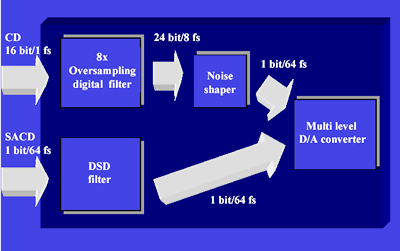
Sony's Super Audio D/A Converter (SA DAC) does an equally superb
job on Compact Disc signals (top) and SA-CD signals (bottom).
The converter consists of a single integrated circuit that contains four significant circuits:
- 8x oversampling digital filter for CD. Ensures accurate phase linearity and low noise.
- Noise shaper for CD to further suppress audible noise. The noise shaper also puts out a 1-bit signal at 64 times the CD sampling frequency (1-bit/64 fs). Sixty-four times 44.1 kHz equals 2.8224 MHz, the same sampling frequency as Super Audio CD. In this way, the SA DAC presents both CD and SA-CD signals to the final converter stage in the identical 1-bit/64 fs form.
- DSD filter for SA-CD, a digital filter that removes unwanted super high frequency noise by computing raw 1-bit digital data. By reducing noise in the digital domain, the DSD filter reduces the burden on analog filters and contributes to the uniformity among channels.
- Multi-level DAC for both SA-CD and CD is a breakthrough design that combines the best attributes of 1-bit converters and multi-bit converters for sound that is exceptionally transparent, against a background that is phenomenally free from noise.
Sony's multi-level digital-to-analog conversion is a significant step forward in audio technology. To appreciate the advance, it's important to understand three types of digital-to-analog converters: multi-bit, 1-bit and multi-level.
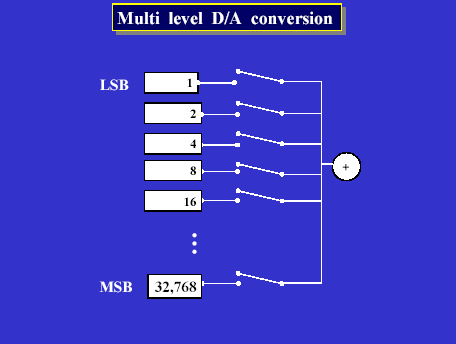
Multi-bit D/A conversion in a typical early CD player employed 16
switches, corresponding to the 16 bits of the CD sample. Each switch
produced a different level of current, according to the significance of the bit.
In the 1980s, the overwhelming majority of CD players used multi-bit Digital-to-Analog converters (DACs). Also called "ladder type" or "resistor ladder" converters, these designs typically used one resistor switch for each in the sample. The value of the resistor controlled the amount of current that flowed when the switch was On. Each switch produced current proportionate to the value of the corresponding bit. For example, the current for the Least Significant Bit (LSB) was 1, the next bit was 2, the next 4, the next 16 and so on up to the 16th or Most Significant Bit (MSB), which had a value of 32,768.
While these converters could offer superb dynamic range, they were susceptible to a distortion called nonlinearity. For any given output level, the combination of switches set On and Off would always be the same. In this way, if a switch's current source had an error, that error would always be reflected in the output level and the linearity would always be spoiled in exactly the same way.
This problem of errors and nonlinearity was especially important in the MSB, because the MSB is so big in comparison to the other bits (for example, 32,768 times the current of the LSB). So even slight errors in the MSB could overwhelm the value of the smaller bits, distorting the musical signal at the zero cross, where the binary digits flip from 1111111111111111 to 0000000000000000. These errors are generally masked by the music, when it is loud. But when the music is soft, this problem of "low-level nonlinearity" can impart a grit or hardness to the music that university researchers found to be audible.
For this reason, technologists developed 1-bit D/A converters that bypassed the problem completely. Significant among these 1-bit designs was Sony's own High Density Linear Converter™ circuit, which made its debut on the landmark CDP-X77ES in 1990 and has since been followed by Sony's Current Pulse 1-bit converter. Like other 1-bit converters, these Sony designs overcame the problem of zero-cross distortion, achieving superb low-level linearity for excellent sound, even during quiet passages and the reverberant tails at the end of musical notes.

The principle of 1-bit D/A conversion. In order to reproduce Super
Audio CD, Pulse Width Modulation must operate at a higher frequency
than the SA-CD sampling frequency of 64 fs (equal to 2.8224 MHz).
These 1-bit converters performed beautifully and dominated CD player
design throughout the 1990s. However, in order to avoid the influence of jitter, to maintain linearity in the time axis, 1-bit converters need to be driven by a
highly precise clock. And Super Audio Compact Disc makes this demand for
precise timing even more stringent. Super Audio CD uses an extremely high
sampling rate of 2,822,400 samples per second—2.8224 MHz. Many 1-bit
converters employ Pulse Width Modulation, in which the converter modulates the
output by creating longer or shorter pulses. Unfortunately, this requires a D/A
converter clock frequency substantially higher than 2.8224 MHz. Because it's
extremely difficult to maintain clock precision at such high frequencies, the signal
is exposed to time-axis errors—jitter—which pass directly into the analog audio
waveform, causing subtle distortion.
Such distortion was not acceptable for the design program of the ES
Series SA-CD players. That's why Sony ES engineers endowed the SA DAC
with Sony's multi-level D/A conversion. Unlike the multi-bit conversion used at
the dawn of the digital age, multi-level conversion exhibits superb low-level
linearity. And unlike the 1-bit conversion, multi-level conversion is remarkably
free from jitter and jitter-induced distortion. You get the best of both worlds.
The multi-level D/A system has multiple switches controlling multiple
current sources—in effect a number of 1-bit digital-to-analog converters operating
in parallel. The analog output is created by summing all the current sources.
Unlike 1-bit DACs, output is expressed not by the pulse width but the number of
the current sources. This reduces the clock frequency, reducing the influence of
clock jitter and reducing the radiation of noise into nearby circuits.

The SA DAC uses multi-level D/A conversion, illustrated here. Like multi-bit conversion,
the multi-level system uses many switches
operating in parallel.
Unlike multi-bit designs, the value of all switchesis identical—a binary 1.

The output of the multi level D/A converter varies from 0 to 64,
depending on the number of switches set to On for each sample.
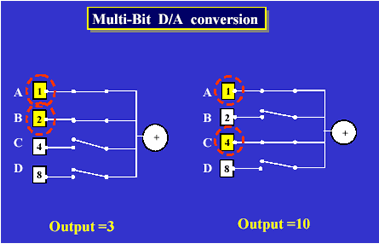 |
 |
Multi-bit conversion (left) versus multi-level conversion (right) |
To appreciate the difference between multi-bit and multi-level conversion,
take a look at the two of them, side-by-side, as shown in the diagram above.
For multi-bit conversion (left), each switch for has its own unique value. For
multi-level conversion (right), all switches have the same value, 1.
For multi-bit, each desired output corresponds to one and only one
combination of switches. For example, there's only one way to generate an
output of 3. In contrast, multi-level conversion has many ways to generate the
same output value. The illustration on the right shows four different switch
combinations that create an output of 2. In fact, Sony multi-level converters can
use thousands of switch combinations to create a given output level. And the
converters select the combinations at random, so output errors tend to cancel
out. And errors never get the opportunity to cause the regular, predictable
nonlinearities of multi-bit designs.
In this way, multi-level conversion achieves high precision in the amplitude
direction and high accuracy in the time domain, for astonishing specifications and
exceptional uniformity on all six channels. But the benefit is far more than just technical. You'll hear reproduction with of superb clarity, transparency and
musicality.
- Tri Power DAC
From the early years of CD players, Sony engineers understood that D/A
accuracy could be further improved by summing the outputs of two or more
complementary converters. Summing two D/A converters for example,
increases the output by a factor of two, while random noise from one converter
partially cancels out noise from the other. Noise is increased by a factor of the
square root of 2 (about 1.42). So the resulting signal-to-noise ratio is
theoretically increased by 42%. (This 42% improvement translates to 3.0 dB better signal-to-noise ratio.)
Sony engineers have applied the same thinking to the SA-CD players of
the ES Series. Sony's Tri Power DAC system applies six DACs per channel,
increasing output by a factor of 3, while noise is increased by a factor of the
square root of 3 (about 1.73). So the resulting signal-to-noise ratio is
theoretically increased by 73%. (This 73% improvement equals 4.8 dB better signal-to-noise ratio.)
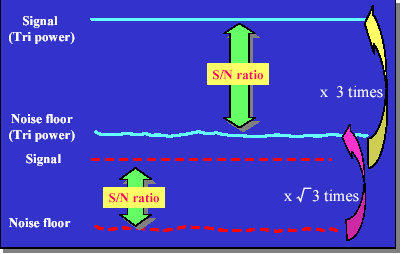
Principle of the Tri Power DAC system. By summing the outputs of six
DACs per channel, Sony increases the signal by a factor of 3, while
increasing noise by a factor of only the square root of 3.
Overall signal-to-noise is dramatically improved.
Sony introduced the Tri Power DAC in 2002, with the SCD-XA777ES
SA-CD player. In 2003, Sony extends the concept with the SCD-XA9000ES.

The Sony SCD-XA777ES has six SA DAC chips with a total of 12 DACs
. In multi-channel operation, each channel's output is created by summing two DACs.
The SCD-XA777ES used six SA DAC chips for 12 DACs total. When
playing back multi-channel SA-CDs, each channel is created by two DACs, for a
theoretical 3 dB improvement in signal-to-noise ratio.

But when reproducing two-channel SA-CDs, Sony introduced a way to take advantage of the full processing power of the SCD-XA777ES. The TriPower DAC system uses six DACs per channel, for a theoretical 4.8 dB improvement in signal-to-noise ratio.
SCD-XA9000ES Tri Power DAC system (multi-channel playback)

The SCD-XA9000ES incorporates an incredible 18 SA DACs, which means
it delivers the precision of the Tri Power DAC system at all times,
even during multi-channel playback. Click the photo above to enlarge.
For 2003, the SCD-XA9000ES elevates the bar with Sony's most powerful
conversion yet. Eighteen separate SA DAC chips deliver the precision of 36
DACs. So the SCD-XA9000ES can bring home the exalted precision of Tri
Power DAC operation, even during multi-channel SA-CD playback. You get
minimum noise, for maximum musical enjoyment.
- Audio Circuit Boards
The SA DACs and other parts that are crucial to the sound quality of the
SCD-XA9000ES are contained on the audio circuit boards. For this reason,
Sony engineers took extra care in every aspect of these circuit boards, from the
choice of materials, to the circuit topology to the selection of individual
component parts.


The boards themselves are environmentally-friendly using halogen-free glass
epoxy material. Careful design of board topology simplifies the signal path.
And Sony has made extensive use of surface-mount parts and leadless resistors,
which cut signal travel to the bare minimum. In this way, the sound is protected
from radiated interference and the uniformity of all six output channels is
improved.
The power supply can become a path for noise to leak from the digital
system board to the audio boards. For this reason, Sony took the extra step of
building a dedicated power supply just for audio. This minimizes even subtle
noise and interference.
6. Construction & Design
Sony SCD-XA9000ES SACD Player - Page 6
Construction & Design
- Discrete Dual Laser Optical Pick Up
The SCD-XA9000ES can play back SA-CD, CD, CD-R and CD-RW discs.
There is substantial difference in the laser wavelength of SA-CD (650 nm) and
CD (780 nm). Sony accommodates that difference with the discrete dual laser
optical pickup. This system has two independent lasers working through a
common lens. One laser handles CD, CD-R and CD-RW while the other
achieves uncompromised reproduction of SA-CD.
The system requires a beam splitter, a special objective lens that can
handle both wavelengths and dual focus. This results in substantially lower
mass than systems with completely separate optical blocks. Lower mass
reduces servo currents, for a corresponding reduction in noise radiated into the
sensitive preamplifier stage. Lower mass also means faster track access, for
greater operating convenience.

- Twin R Core Transformers
The video and control circuits can introduce noise to the power supply
voltage, which can trigger audio distortions. To protect the audio circuitry, the
player uses two separate power transformers: one for the servo and digital
system and another just for audio. In addition, power supply regulation on the
audio circuit board itself helps establish stable operation for the audio D/A
converters.
Power transformer cores and windings can vibrate and degrade the
sound, radiating 60 Hz hum into nearby audio circuits. That's why Sony chose
an R-Core design. The R stands for round. Not only is the core round, it has a
cylindrical cross section, enabling the transformer windings to be wrapped
without the voids or gaps that permit vibration. This results in far less radiation,
far less hum. These two transformers are mounted on a copper plate, which is
quite effective in reducing vibration. The audio power supply circuit also
incorporates discrete components, including electrolytic capacitors, carefully
selected for their sound quality.

The two power transformers have round cores with cylindrical cross
sections. This enables far more consistent transformer windings—for
far less radiated hum.
- Frame and Beam (FB) chassis
Vibration is the enemy of CD and Super Audio CD players for two powerful
reasons. First, vibration in the disc or optical pickup triggers unwanted
operation in the tracking servos. This can radiate spurious noise throughout the
chassis. And this radiation occurs in exactly the wrong place—near the
sensitive, low-level optical pickup preamplifier. To make matters worse,
vibration can also cause subtle distortions in the audio circuitry. Vibration can
have tiny "microphonic" effects on capacitor values and point-to-point wiring.
While these distortions are not always apparent to the casual listener, Sony's
design program required performance without compromise. For all these
reasons, the SCD-XA9000ES incorporates Sony's anti-resonant Frame and
Beam (FB) chassis.
In the SCD-XA9000ES, Sony's Frame and Beam (FB) chassis uses a
thick, high-strength frame which gains additional rigidity from two broad metal
girders or beams that cross the chassis from front to back. For even greater
rigidity, the juncture where the beams meet the chassis front is reinforced by
triangle braces. To further suppress resonant modes, Sony engineers selected
metal members of different shapes and sizes to cancel unwanted vibration.
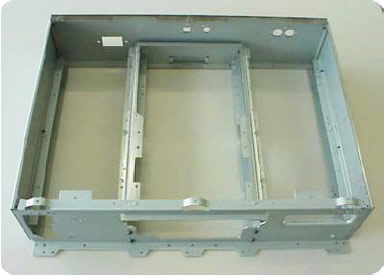 |
 |
Front view (left) and side view (right) of Sony's Frame and Beam (FB)
chassis. It's supremely strong to suppress resonance. |
The two beams have the added function of supporting the player's
mechanical drive unit. Unfortunately, the two beams never have exactly the
same length. This means that the mechanical block can exert slightly different
tension on the beams, potentially exciting different vibration modes and
generating unwanted chassis resonance. To combat this resonance, Sony
engineers decoupled the beams from the rear panel. The beams connect to a
rigid metal frame, which is connected to the rear panel. This design restricts the
potential for whole-chassis vibration.

Schematic view of the chassis design, showing the chassis beams (light
blue), mechanical drive unit (violet) and audio circuit boards (orange).
- Silver Cascade Design
In addition to its remarkable technology, the SCD-XA9000ES inaugurates
a new faceplate design exclusive to the Sony ES Series. The "cascade" design
sets all the primary front panel controls at an angle, so that you can operate the
front panel without uncomfortable bending and stooping to identify each control.
The silver colored faceplate is made of brushed aluminum and fits in beautifully
with conventional audio components. But the design really comes into its own
when the SCD-XA9000ES is combined with other silver cascade components,
such as the STR-DA9000ES.

The STR-DA9000ES shows how the Silver Cascade design extends to
receivers. The design is also featured on the STR-DA5000ES and
DA3000ES.
7. Unpacking
Sony SCD-XA9000ES SACD Player - Page 3
Unpacking

The retail package includes the following:
- Audio connecting Stereo cable ( x3)
- Coaxial
Digital cable ( x2)
- iLink
Digital cable
- Power cable
- Remote commander RM-SX700
- R06 ( size AA) batteries ( x2)
- Multi language manual
- Warranty


On the right on the front panel there are the eject, play, pause,
stop, skip (AMS) and fast forward buttons.
On the left there are the power button, a headphone jack with volume level
adjust. The five remaining buttons handle read text from
the disc, entering the unit's menu, changing between Multichannel to Stereo
2CH
and SACD
to CD and enable the iLink.
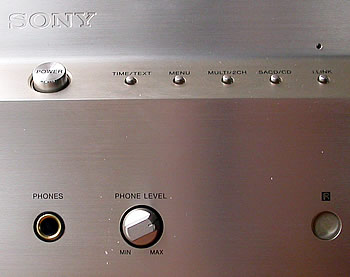
click to enlarge
The RM-SX700 remote control is easy to use and includes everything for controlling
the player apart from eject.

click to enlarge
When we removed the player's cover, which is something we don't recommend
you to do, we witnessed Sony's amazing handiwork. The picture
below speaks for itself.

Inside the SCD-XA9000ES SACD Player
Click to enlarge
Below is the internal layout of the SCD-XA9000ES as seen from the back.
Notice the R-Core power transformers (1), the digital circuit (2), the analog
audio circuits (3), and the i.LINK output circuit (4), near the center of
the back panel.

As you can see in the pictures below, everything in the SCD-XA9000ES is
made by Sony.



Below you can see Sony's well known chipset, which is also installed in
many other devices, the CXD2753 DSD decoder responsible for SACD reproduction:

DSD decoder LSI
The Super Audio CD's 1-bit signal is processed and decoded by Sony's CXD2753
DSD decoder LSI. This integrated circuit makes intelligent decisions regarding
the incoming data to form the 1-bit audio signal. The LSI first reads the
Watermark, a feature protecting Super Audio Compact Discs from piracy, and
then decodes the incoming data. The LSI uses internal memory to take data that's
output intermittently from the disc, rearrange it and order it into continuous
1-bit audio streams. This LSI also reads sub code data such as the Table of
Contents, track number, track time, and text data.
- Rear Panel
On the rear panel there are the stereo 2CH outputs as well as the Multichannel
5.1CH outputs, which means that the unit has a built-in 5.1CH decoder. Both
coaxial and optical digital outputs are a feature of the unit.
The great difference here is the iLink connection provided, with all the
advantages
we described in a previous page.




8. Control Menu
Sony SCD-XA9000ES SACD Player - Page 8
Control Menu
Below we provide some screenshots of the player's menus. As you
can see, it is almost the same as those of the SCD-XB790 device.
There are only a few new things added, such as the iLink.

CD reproduction

SACD 2CH reproduction

SACD MCH reproduction
 |
 |
| CD-Text |

90min Test Disc

99min Test Disc

Shuffle
 |
 |
| Program function with A-B repeat feature |
- Menu




In "Speakers Distance", you can adjust the surround, center, subwoofer
and unit distance separately. For example:


From the "MCH SPK MODE" option in the Menu, with SACD enabled,
you can select your preference from among 7 settings. These are:
| Playback Mode |
Front Speakers |
Center Speaker |
Surround Speakers |
Sub woofer |
| MCH Direct |
Each signal outputs directly from each speaker |
| 5-Large + SW |
Large |
Large |
Large |
Yes |
| 5-Large |
Large |
Large |
Large |
No |
| 5-Small + SW |
Small |
Small |
Small |
Yes |
| FRT-Large + SW |
Large |
Small |
Small |
Yes |
| FRT-Large |
Large |
Small |
Small |
No |
| No-CNTR + SW |
Large |
No |
Large |
Yes |
| No-CNTR |
Large |
No |
Large |
No |
For example:




Also, the balance between the front and the rear, or the center or the
Sub woofer is adjustable. For example:



If it is set to "2CH SPK MODE", there are two available settings:
| Playback Mode |
Front Speakers |
Sub woofer |
| 2CH Direct |
Each signal outputs directly from front speakers. No signal outputs from the Sub woofer. |
| 2CH + SW |
Yes |
Yes |
Navigation through the device's menu system is easy. The included manual
will provide you with all the appropriate information for operating
the player.
When the device is in playback mode, a green light is lit while an
orange one when it is paused.



There is a blue light over the iLink button. This turns on when iLink is
active.
9. Reading Tests
Sony SCD-XA9000ES SACD Player - Page 9
Reading Tests
The Sony SCD-XA9000ES supports mainly SACD/CD playback.
The *.cda files of an ordinary audioCD are recognized flawlessly, regardless
of whether the disc is factory pressed or is a CD-R/RW. In addition, CD-Text
is also supported.
 We noticed
no problems when we played 8cm CD-R/-RW (185MB). On the other
hand, our 99min test CD-R reported low audio quality while playing
the last track, the 25th. In the case of our 90min test CD, the SCD-XA9000ES
managed to play the first 17 out of the 20 tracks. On the 18th track, playback
froze
while the device couldn't seek on the 19th and 20th tracks.
We noticed
no problems when we played 8cm CD-R/-RW (185MB). On the other
hand, our 99min test CD-R reported low audio quality while playing
the last track, the 25th. In the case of our 90min test CD, the SCD-XA9000ES
managed to play the first 17 out of the 20 tracks. On the 18th track, playback
froze
while the device couldn't seek on the 19th and 20th tracks.
If you have any protected audio discs, you won't have any problems since the
device can play them without problems. The discs we tested were "Natalie
Impruglia - White Lilies island" protected with Macrovision' Key2Audio
system, and "Celine Dion - A New Day Has Come" protected
with Cactus Data Shield 200. Both titles were recognized and played flawlessly.
After all, those protection schemes
are designed to discourage PC users from copying them and as such
are not playable on PCs only.
-
Compressed Audio (data CD)
 Although
the specifications for this player don't mention MP3 playback, we decided to
test it anyhow. None of the following compressed audio formats can be
played with the player.
Although
the specifications for this player don't mention MP3 playback, we decided to
test it anyhow. None of the following compressed audio formats can be
played with the player.
Compression type |
Compression settings |
Recognize / Play |
MP3 |
CBR 20kBit 11025Hz Mono |
No
|
CBR 20kBit 11025Hz Stereo |
CBR 32kBit 11025Hz Stereo |
CBR 32kBit 22050Hz Mono |
CBR 40kBit 22050Hz Stereo |
CBR 48kBit 22050Hz Stereo |
CBR 48kBit 44100Hz Mono |
CBR 56kBit 22050Hz Mono |
CBR 56kBit 44100Hz Mono |
CBR 64kBit 22050Hz Stereo |
CBR 96kBit 22050Hz Stereo |
CBR 96kBit 44100Hz Mono |
CBR 96kBit 44100Hz Stereo |
CBR 112kBit 44100Hz Stereo |
CBR 128kBit 44100Hz Mono |
CBR 128kBit 44100Hz Stereo |
CBR 160kBit 44100Hz Stereo |
CBR 192kBit 44100Hz Stereo |
CBR 224kBit 44100Hz Stereo |
CBR 256kBit 44100Hz Stereo |
CBR 320kBit 44100Hz Stereo |
VBR - High compression |
VBR - Highest compression |
VBR - Low compression |
VBR - Lowest compression |
VBR - Medium compression |
Windows Media Audio
(WMA)
|
WMA 48kbps |
WMA 64kbps |
WMA 96kbps |
WMA 128kbps |
WMA 160kbps |
WMA 192kbps |
WAV |
WAV |
The Sony SCD-XA9000ES is a high-end device and caters to a small number
of people who are willing to pay the relevant amount. It wouldn't be fair to
compare
it to another cheaper and simpler device and it is certainly several levels
above normal SACD players. We played many SACDs and some standard CDs.
In the case
of
2CH for SACD, the sound quality was amazing while when we inserted a MCH SACD,
we were left speechless. If you put a few players side by side, you can generally
notice the difference at once. This was our first review of such a High-End
SACD device
and as such, we found the device to be the best SACD player
we have heard. It is simply leagues ahead of ordinary devices.
10. Error Correction Tests
Sony SCD-XA9000ES SACD Player - Page 10
Error Correction
Tests
This
is an AudioCD disc used for measurement and adjustment of the error correction
capability and tracking/focusing servo characteristics of a player
against the defects included in some CDs. Three kinds of defects are included
on this disc, interruption in the information layer, black dots and fingerprints.
The interruptions are fabricated by intentionally varying the lengths of pits
in the disc fabrication area. Their size varies from 0.5mm to 1.0mm. The diameter
of the black dots are sized of 0.4mm to 1.0mm. Last, the simulated fingerprints
are small gathered dots, of diameters sized from 65 micro-meters to
75 micro meters. 160 black dots in total, go to make up the artificial
fingerprint.
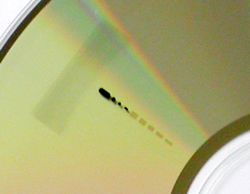
The interruptions of 0.5 to 1.0mm in the information layer was not a problem
as it weren't the 65 to 75 micrometer fingerprints. The black dots over
the 1.0mm size produced some audible clicks, but the 0.8mm was not a problem.
This
is supposed to be the easy test disc and as such, the SCD-XA9000ES should have
performed better.
The
test concept with the Philips SBC 44A is the same as in the previous test disc.
Interruptions on the information layer vary from 400 micrometers to 1000
micrometers, while the black dots have a size of 300 micrometers to 800 micrometers
No audible click or skip was heard during playback, indicating very
good performance.

Same contents as with the Abex TCD-726, but different defect. A scratch sized
of 0.4mm to 3.0mm is on the disc's surface. Error symptoms expected when
playing this disc are noise, sound skips, same sectors repeatedly played, start
of tune cannot be detected etc. This test disc is more difficult than the Abex
TCD-726.
The performance of the Sony player is similar to that of the SCD-XB790. The
first five tracks, with scratches up to 0.8mm, were played without problems
while the sixth produced some audible clicks which were becoming more and more
pronounced as
the scratch size increased. The device failed to seek over tracks where
the scratch size was 2.0mm and higher.
We finish this test cycle with the CD-Check disc from Digital Recordings.
Five audio signals (5 tracks) in combination with disc error patterns to rate
the player's ability to read music and reproduce it completely. The five tracks
contain a sequence of progressively more difficult tests.

Check level 1 (track 1): Standard manufacturing errors
Check level 2 (track 2): 0.375mm scratch
Check level 3 (track 3): 0.750mm scratch
Check level 4 (track 2): 1.125mm scratch
Check level 5 (track 2): 1.500mm scratch
Any clicks, interruptions
or looping during audio reproduction indicate failure of a Check level (audio
track). Below you can see the test results:
Check level |
1 |
2 |
3 |
4 |
5 |
Result |
OK |
OK |
OK |
Audible clicks |
Audible clicks |
It seems that this is a very demanding player :-;
11. Conclusion
Sony SCD-XA9000ES SACD Player
- Page 11
Conclusion
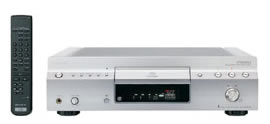
We had the SCD-XA9000ES several weeks in our labs for testing, thanks to
Sony. There are no words to describe the quality of the overall construction.
The Audio Circuit Boards, the R-Core power
transformers,
the
digital circuit,
the analog audio circuits, with a Tri Power Digital-to-Analog Converter using
eighteen separate SA DAC chips, and the i.LINK output circuit indicates what
a great job Sony has done. Next to the SCD-XA9000ES, many devices,
even those costing $1000, look cheap. However, the $2000 price tag for
the player is a
huge amount to spend. But then, this is a High-End proposal, a flagship
for Sony and not many people can acquire such a device. For this reason,
it would
not be fair to judge the SCD-XA9000ES in the standard way we do with
other standalone players. I think most candidate buyers don't care how capable
the CD error
correction is or if it can reproduce compressed audio. The purpose of this
player is to produce high quality sound from SACD media, and in this respect,
the player is simply superb. The rest will take it as a lifestyle
:-)
Don't forget that for judging the sound quality of this SACD device, you'll
need similar quality components as far as an amplifier
and speakers are concerned.
